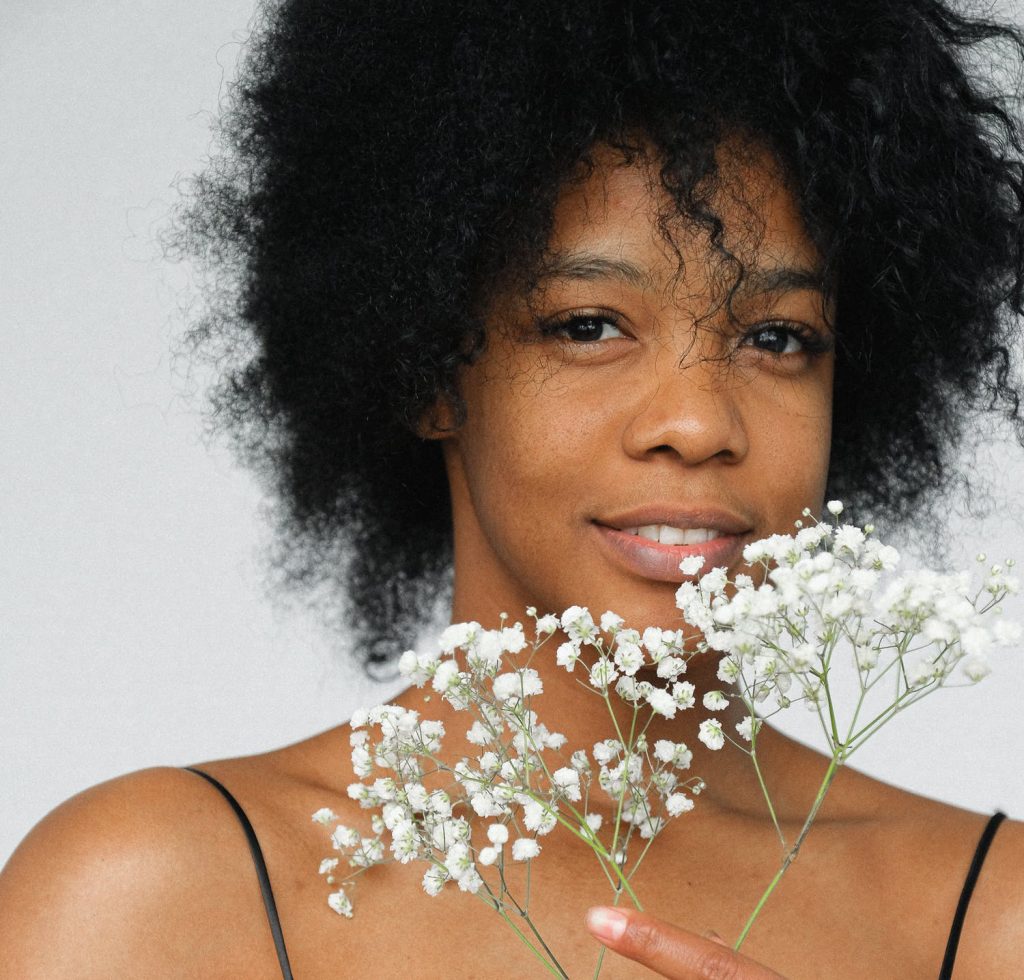
A Comprehensive List of Things You Need to Have in Your Diet for Healthy, Glowing Skin
By: Simone Gisondi, RHN
We all wish there was a way to turn back the clock — or at the very least to stop it from ticking.
Unfortunately, this is not possible (yet?), but the good news is that there are things we can all do
to improve the function and the appearance of our skin and to slow down the rate of the aging
process.
Our skin is our largest vital organ and its jobs are numerous. They range from temperature
control, production of Vitamin D through exposure to sun, elimination (via sweat and oil) as well
as protection — it is one of the first lines of defence between our internal environment and the
outside world. Our skin works alongside our body’s other defense systems to protect us from
viruses, bacteria, pollution and other harmful environmental factors.
Much like the rest of our health, skin health is also affected by genetic predispositions, age, hormones and illnesses.
This incredible organ relies on our diet and lifestyle for its health just as much as all other
organs do, so it’s important that we care for it the way we care for any of our other organs since
the diet provides it with the nutrients it needs and the lifestyle provides the support — in
essence, lifestyle is the diet’s co-pilot.
Lifestyle-related factors like smoking, tanning, lack of exercise, inadequate sleep, too much
alcohol, emotions as well as high and prolonged stress levels affect our skin just as much as our
nutritional habits do — so it goes without saying that we should have a healthy lifestyle if we
want healthy, glowing, beautiful skin. Healthy skin requires commitment — commitment to
exercise, getting enough sleep, keeping stress at bay and staying away from those bad habits.
Sure, cleansers, serums and moisturizers help, but gorgeous, glowing skin starts from within.
Just as what we apply on our skin brings the outside world in, so do what we eat and drink.
What we consume every day affects not just our overall health but also the health, structure and
appearance of our skin.
For example, excessive caffeine consumption typically from coffee and/or energy drinks not only
disrupts sleep, it also raises the infamous stress hormone cortisol, which stimulates skin
glands to produce excess oil which in turn leads to acne, especially for those prone to acne.
Cortisol — and stress — also make it harder for the skin to heal. This is actually a double dose
of trouble for skin, since lack of sleep alone contributes to bad skin. Add cortisol to it, and you
have yourself a great recipe for skin problems.

Consumption of processed and refined sugars as well as artificial sweeteners cause
inflammation everywhere in the body. For skin in particular, bad sugars lead to the breakdown of collagen and elastin, both of which are required for skin elasticity and strength.
On the other hand, food that’s full of nutrients has a very beneficial effect on skin because it is
these nutrients that are involved in the development and maintenance of the skin and its health.
A healthy complexion doesn’t come from a jar or a bottle, it comes mostly from what’s on your
plate and in your cup. Whether addressing a skin condition, trying to keep premature aging at bay, treating acne or aiming to reduce the appearance of wrinkles, the right diet is hands down the most important step and the best approach.
So, what’s the diet secret to healthy, glowing skin? Eating a diet rich in powerful nutrients like healthy fats, vitamins, minerals and antioxidants, of course!
In fact, research has shown that consuming certain healthy and nutritious foods on a regular basis helps with skin health by preventing certain genes from expressing and by providing the body with the nutrients necessary to regenerating tissues and building healthy ones. So, let’s build a diet fit for beautiful, glowing skin.
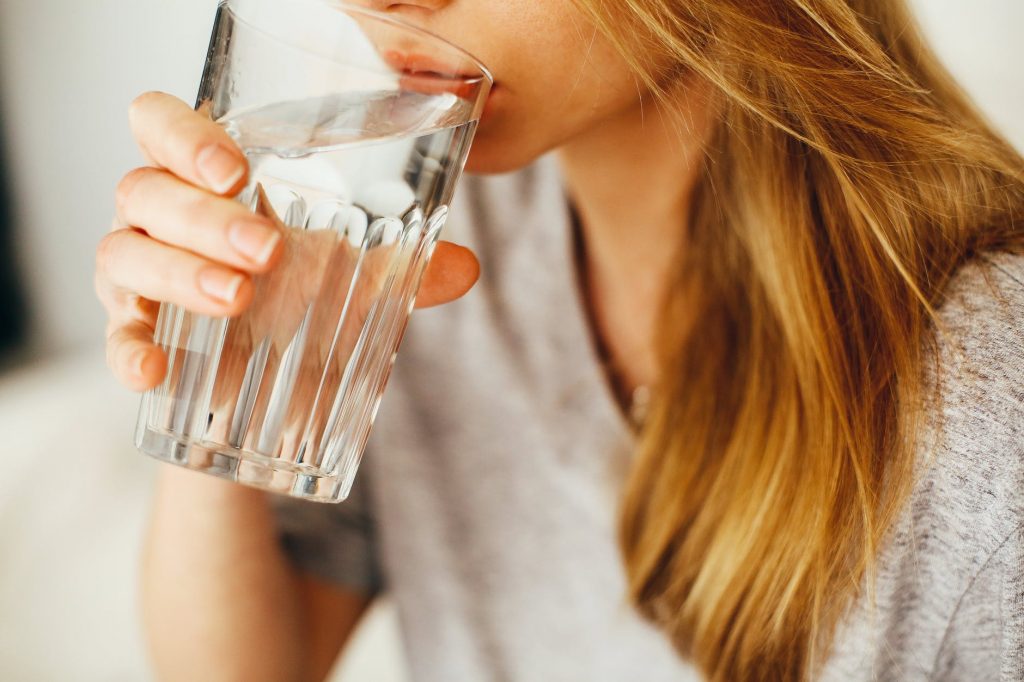
1. Hydration
Water
We all know that the number one ingredient in most skincare products is water — from toners to foundations and from moisturizers and cleansers. Healthy, glowing skin starts with water, so if you’re slathering on foundation or concealer to hide the puffy, dark circles under your eyes, you’re not addressing the main causes (read: dehydration and liver issues), you’re just masking the symptoms at hand. Alcohol, salty and processed foods as well as not drinking enough water is what causes the puffiness and dark circles under the eyes. Alcohol, salt and refined foods dehydrate the body, which in turn causes it to retain water that is desperately low on. It also overburdens the liver. So, skip the concealer, as well as the alcohol and crappy foods, and hydrate instead. Once the body sees that water comes in on a regular basis, it won’t have a reason to retain it.
If you’re like me and can’t stand bland water, opt for cold herbal teas or coconut water instead (more on coconut water in a bit). Alternatively, add some cucumber and mint or pieces
of organic citrus fruits with the rind included to a pitcher of regular (but clean and filtered) water, allow it to infuse and give your skin what it needs to get its glow on — this amazing detox water. The natural vitamins found in the fruits never hurt anyone, and they will help flush out the retained water along with accumulated toxins.
All cells including skin, nail and hair cells need water for their health, so the importance of
staying hydrated throughout the day goes without saying. Consume a minimum of 2L, but
ideally 3-4L of water per day to give your skin what it needs to stay healthy.
Coconut Water
Coconut water is 95% water, but it contains the perfect ratio of electrolytes to replenish dehydrated tissues, including skin. It also contains muscle-relaxing potassium, so it’s a great choice for amazing skin as well as for post-workout rehydration.
Coconut water also contains cytokinins, a group of plant hormones that regulate growth and are primarily involved in performing cell division, which studies have found have significant anti-aging effects.
Coconut water also has anti-carcinogenic and anti-clotting properties making it a must-have, not just for health, but also for well-hydrated, radiant, firm skin.
This much-loved elixir of health is considered safe to be consumed during pregnancy, by infants, the elderly and anyone in-between. It’s also really great during illness. Consume alone or as part of smoothies and always choose the organic kind that does not contain additives like sugar.
Green Tea
Few teas can boast what green tea can thanks to its powerful antioxidants and vitamins. Catechins are the amazing natural antioxidants found in this tea, and they help prevent cell damage, eliminate free radicals that speed up aging, minimize redness, irritation and inflammation. They also offset the effects of sun damage and environmental pollution.
Loaded with Vitamins B2 & E, green tea is also great for maintaining collagen, an absolute necessity for youthful, firm skin. Skin’s favourite superhero, Vitamin E, promotes the growth of
new skin cells, nourishes and hydrates.
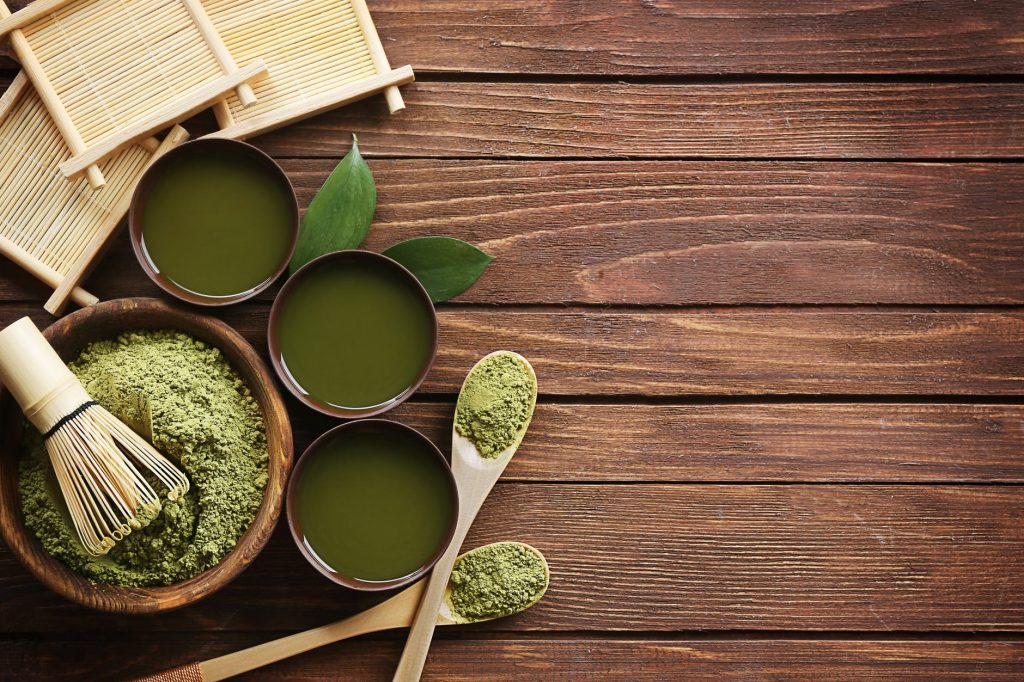
But there’s more. Green tea also has antibacterial properties making it great for treating acne and unclogging pores. It’s also useful for combating bacterial growth that causes acne. Make it part of your skincare routine and apply it topically, cooled down as a toner, to help kill bacteria and tone your skin.
A 12-week study of green tea-drinking women found that drinking this tea daily could reduce redness from sun exposure by up to 25%. Green tea also improved the moisture and other properties of the skin.
Do your skin a favour and splurge on the matcha version of green tea and consume this
incredible elixir of health and beauty instead of coffee. Why matcha? Because it’s grown and
prepared differently. The leaves are dried and ground into powder in their entirety so you’d be consuming the whole leaf, accessing all its nutrients and benefits.
But beware: along with all the great nutrients and antioxidants, green tea also contains caffeine,
so limit consumption to one cup in the morning instead of your cup of java.
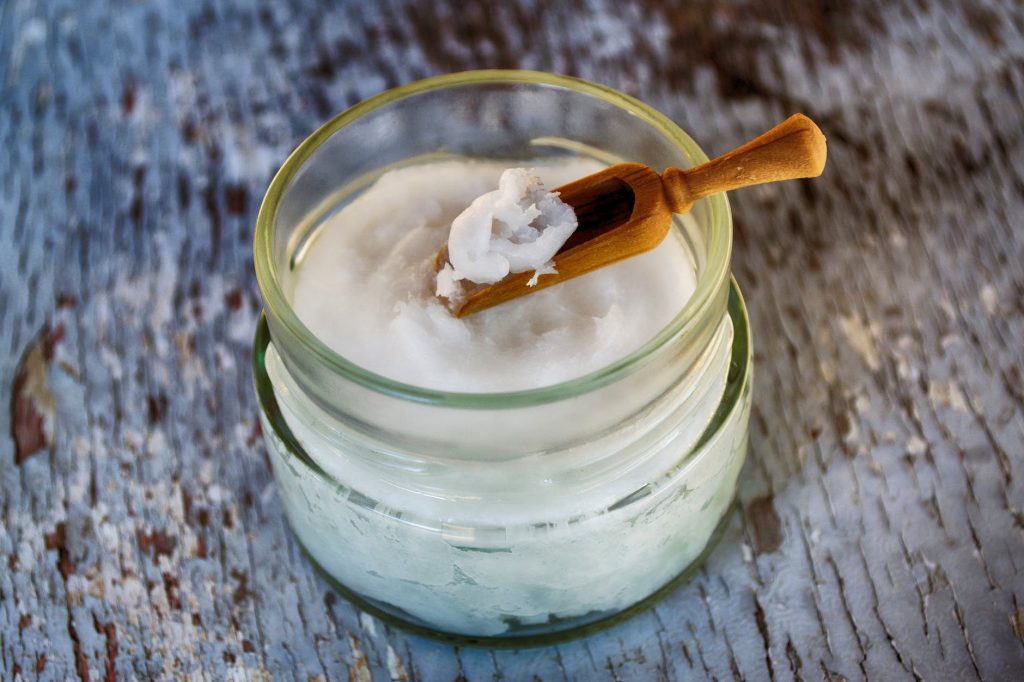
2. Healthy Fats
Coconut
If you love coconut like I do (and by love, I mean if you’re obsessed with it), you know that this amazing fruit (yes, it is a fruit) delivers so much nutrition that there’s nothing that goes to waste. Even its shell is turned into activated charcoal.
Its meat contains nature’s greatest and most nourishing fats, great for helping heal the gut thanks to the potent antimicrobial caprylic acid, which helps combat bad bacteria and candida (the fungus that causes yeast infections), deteriorates the intestinal wall and depletes the stomach of hydrochloric acid (which leads to poor digestion, inflammation and poor skin health).
Coconut is also a source of minerals such as potassium, manganese, selenium, phosphorus and iron. Oh, it’s a good source of fibre, too.
And that’s not all by a long shot. Coconut oil is so great and versatile that you can literally use it when you cook, as a hair mask, in your smoothie, and most definitely as a skin moisturizer. Why? Because half of coconut’s fatty acids are lauric acid, a medium-chain long fatty acid with incredible antibacterial properties known to reduce inflammation and the number of bacteria on the skin. This effectively combats acne that develops as a result of the skin’s bacteria overgrowth. The amazing lauric acid is also very effective against psoriasis, thanks to its antifungal and antibacterial properties. To reap these incredible benefits, always use virgin coconut oil, instead of the refined variety.
And the benefits don’t end there. Coconut oil can also be used as a very cost effective and highly nutritious all over body moisturizer after sun exposure or daily after the shower. Add a few drops of an essential oil like lavender if you want to augment the calming and anti- inflammatory properties of it.
Coconut oil doesn’t favour any skin, it loves them all equally, so it’s safe on all skins and skins of all ages, from babies to the elderly — but remember that the virgin kind is where all the nutrients and benefits are.
Use coconut oil liberally topically and as part of smoothies, stir-frying, salad dressing and as a
plant-based butter instead of butter derived from dairy.
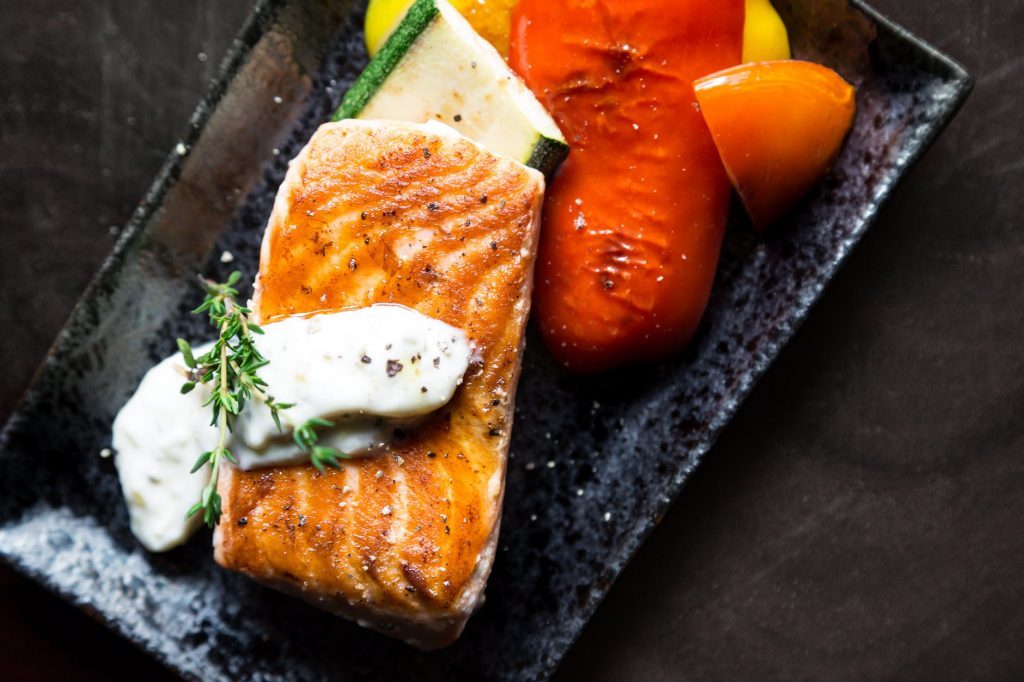
Fatty Fish
If you enjoy fish, fatty fish such as Alaskan Salmon, Arctic Char, Atlantic Mackerel, Sardines,
Rainbow Trout and Herring are healthy skin’s best friends given how rich they are in Vitamin E
and Omega-3 Fatty Acids. Vitamin E is skin’s favourite superhero because it’s one of the best antioxidants that also protects against damage from inflammation and free radicals.
Omega-3 Fatty Acids are also great for reducing inflammation, the main cause of acne and skin
redness. They are also necessary for keeping skin well moisturized, supple and thick. Lacking this healthy fat can lead to dry skin.
Fish is also a great source of protein, needed for the maintenance of skin’s overall health and strength, as well as the precious mineral zinc, necessary for the production of new skin cells, skin healing and keeping inflammation at bay. Other amazing Omega-3 Fatty Acids to include in your diet are chia seeds, flaxseeds, walnuts, leafy greens and hemp seeds.
Essential fatty acids are, as the name suggests, essential. Why? Because they keep cell
membranes elastic and functioning well. Being natural moisturizers, EFAs also help reduce dryness, leaving skin feeling and looking smoother and plumper. They are also able to reduce inflammation levels in the body and have therefore been found useful in addressing conditions such as eczema, psoriasis and acne. Plus, they have been shown to be protective against sun
damage.
In fact, according to the Skin Cancer Foundation, Omega-3 Fatty Acids can help prevent skin cancer by inhibiting the formation of the COX-2 chemical. Choose the wild kind to avoid the damage done to it from the processed, high protein and high fat fish feed (done in order to yield bigger fish). The calorie content and nutrient profile vary vastly between the two. Consume grilled for the greatest health benefits.
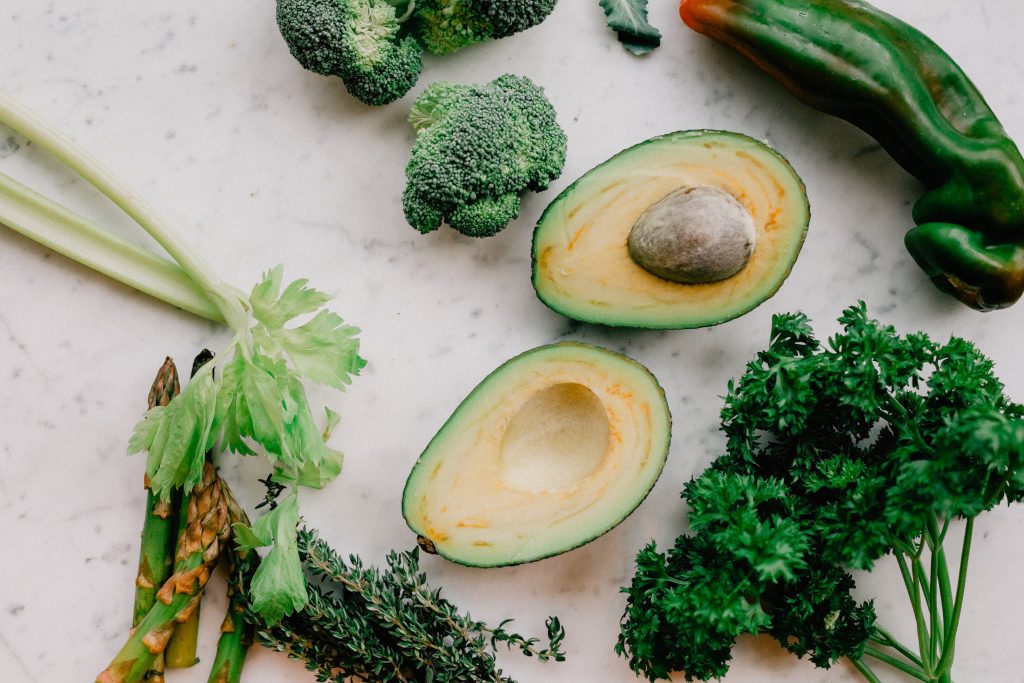
Avocados
Avocados are high in healthy fats and a great source of the famous antioxidant, Vitamin E,
which helps protect skin from oxidative damage Unfortunately, most North Americans don’t get
enough Vitamin E from their diet. Avocados also provide another great antioxidant, Vitamin C, also essential for healthy skin and necessary for the creation of collagen, skin’s main structural protein that keeps it strong and healthy.
Vitamin E is known to be more effective when combined with Vitamin C, so they are both essential to a healthy skin diet.
A salad is just not a salad without avocado — so simply add it to your salads. Squeeze in some lemon juice, and you’ve got the perfect Vitamin E and C combination that your skin will love you for. You can also enjoy as part of guacamole, on bread as part of avocado toast or topically as a moisturizing face mask.
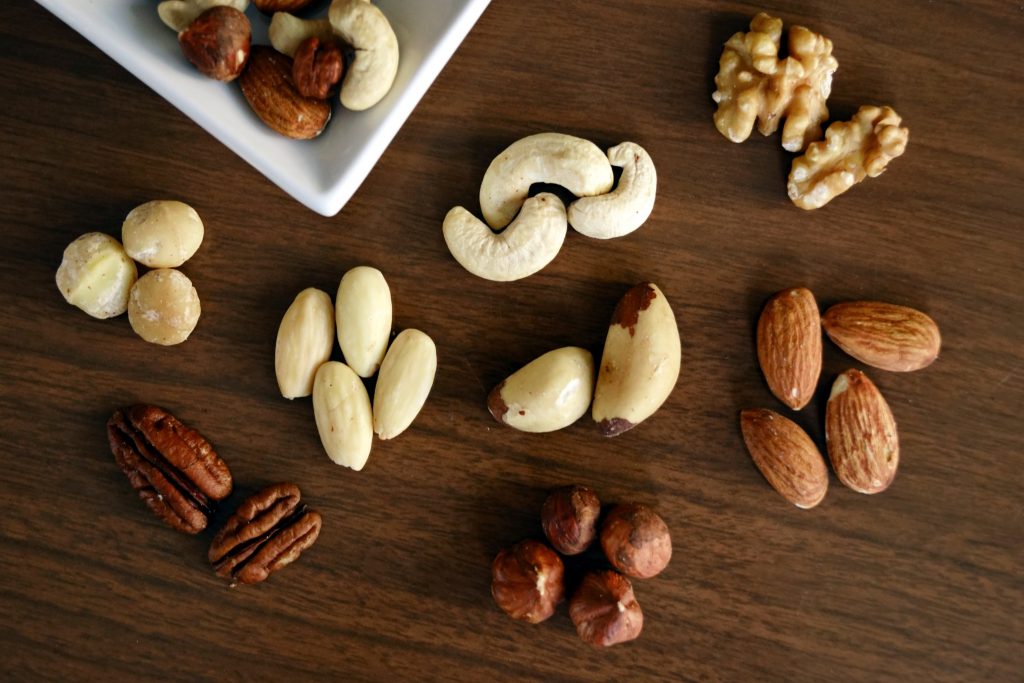
Walnuts
Walnuts are a great source of essential fatty acids. One ounce (28 grams) of this amazing nut contains zinc, necessary for preventing and fighting inflammation as well as for wound healing, and 4-5 grams of protein. Walnuts also contain the great antioxidants Vitamins C and E, and selenium, an antioxidant that also plays an important role for bodily processes such as metabolism and thyroid function.
Want to turn your salad into a super-salad? Throw that ounce of walnuts into it to amp up its
antioxidant power and for some protein without hurting an animal.
Brazil Nuts
Dark circles creep up under the eyes as we age because the liver is overworked or inflamed and because the skin starts to lose collagen and thin out. So how do you boost collagen without resorting to supplements? Include Brazil nuts in your diet. A single nut contains a whopping 135% of the recommended daily intake of selenium — the antioxidant that stops free radicals created by UV exposure from damaging cells, the mineral that can boost the production of collagen, the nutrient that helps preserve elastin and the protein that keeps skin smooth and tight.
This mighty nut also contains the famous antioxidant Vitamin E as well as copper which
supports the production of melanin, the natural pigment in the skin.
So, skip the crappy snacks and have a few Brazil nuts instead. They make a better and more
nutritious snack that even your skin will thank you for.
Almonds
Like all other nuts, almonds are chock full of the most loved antioxidant in skin care — Vitamin E. It’s loved because it helps repair damaged skin cells and keeps free radicals away. Aside from Vitamin E, almonds contain Omega 3-Fatty Acids, 3.5 g of fiber per ounce and they also happen to be one of the best sources of dairy-free calcium.
Ground, they make a great and very gentle scrub and added to smoothies brings in the much-
needed calcium sans dairy. Enjoyed as almond butter with an apple gives you an amazingly
nutritious snack full of nutrients your skin will love.
Flaxseeds
This little seed packs a lot of power. Not only is it a great source of Omega-3 Fatty Acid Alpha Lipoic Acid (ALA) — which protects the skin from sun radiation and can reduce sun related skin damage like sun spots — it also helps alleviate skin inflammation and hydrates and smooths skin. A British Journal of Nutrition study reports that participants who consumed about half a teaspoon of Omega-3s over a 6-week period experienced better hydrated skin, significantly less redness and less irritation, thanks to Omega-3’s anti-inflammatory properties. It’s best consumed as an oil in salad dressing or ground and sprinkled on salads and in smoothies.
You can also mix it with ground almonds to make a nutrient-packed scrub and slough off those dead skin cells to reveal the glowing skin underneath.
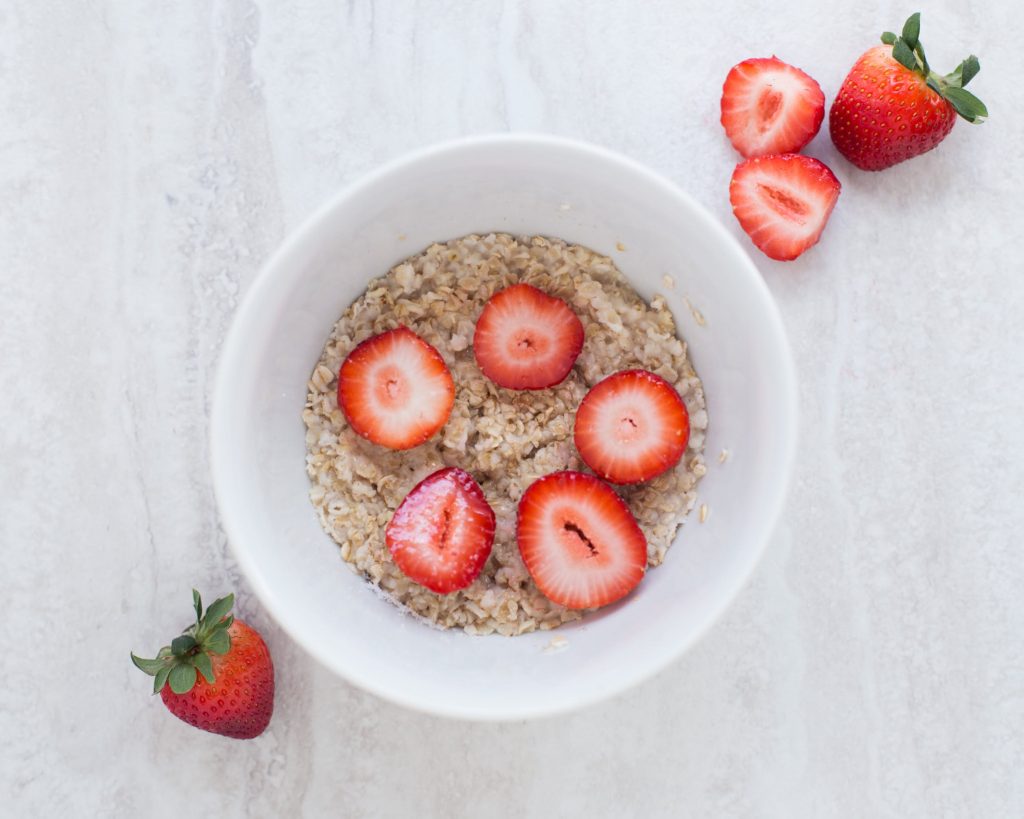
3. Grains
Oats
Not only does this beloved breakfast staple boast a hefty amount of fibre that will feed the
inflammation-fighting good gut bacteria, oats are also gluten-free and a high source of silicon,
the trace mineral that helps with skin elasticity and slowing the signs of aging. Oats are also the
perfect pre-workout meal that will keep you satiated and your blood sugar stable, plus it goes
really well with nuts and fruits, like walnuts and almonds, bananas and berries.
Breads and Pastas
White breads, white (or regular) pizza dough and white pastas are all made with processed flours that been stripped of their natural nutrients and come from crops that have been genetically modified and/or sprayed with pesticides, which in turn causes inflammation, spikes blood sugar and insulin levels, disrupts the body’s natural hormonal balance and offers little more than excess empty calories. Products made with white flour are also high on the glycemic index, thereby affecting weight and the body’s overall health, which in turn will also impact skin health as well. Hormonal acne is not something that only affects teenagers anymore.
If you grew up eating (and loving) bread and pasta like I did, naturally you want to be able to continue having them, but not at the expense of your health or that of your skin. Luckily, we now have access to breads and pastas made with low glycemic, gluten-free flours like kamut, buckwheat, sorghum, amaranth, teff and cassava, which are also really great for making pancakes, crepes and waffles.
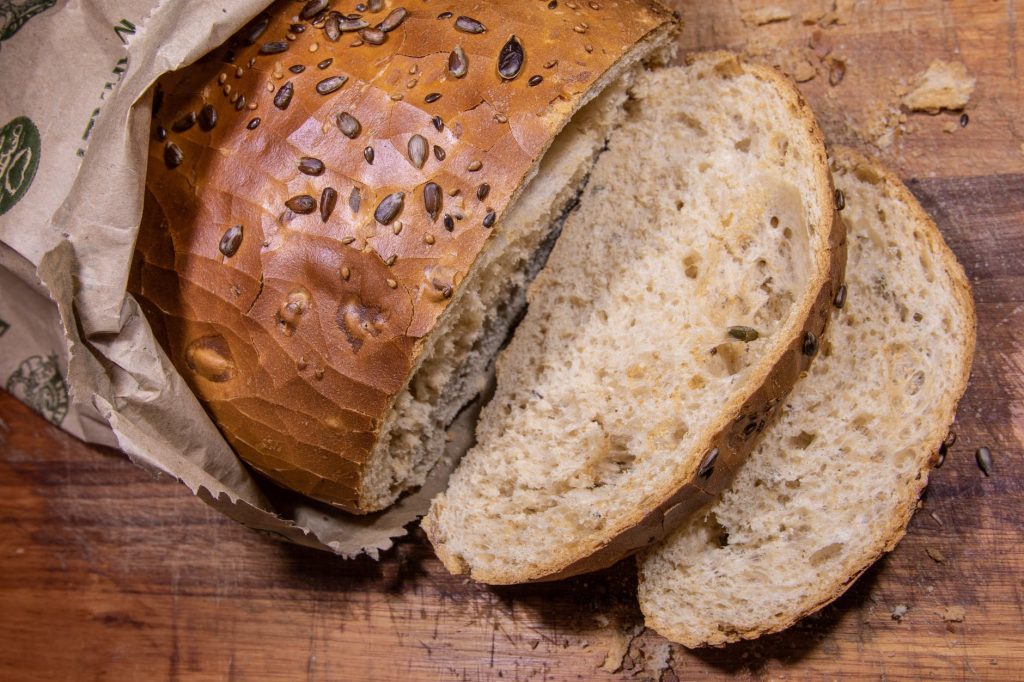
Sprouted grain bread is packed with nutrition because it’s made using the whole grain and with a variety of legumes that makes the protein complete in the bread by offering all 9 essential amino acids. It’s also lower in carbs, higher in fibre and protein, plus it’s easier to digest. Sprouted grain bread is also lower in gluten and is much lower on the glycemic index compared to regular breads.
My personal favourite, Ezekiel 4:9® Sprouted Whole Grain Bread, is made from 6 sprouted,
organically grown grains and legumes like wheat, barley, millet, lentils, soybeans and spelt.
A 10-week Korean study of individuals with mild to moderate acne found that those who consumed a low-glycemic diet decreased the severity of their acne compared to those who consumed a high-glycemic diet.
Another reason to ditch the white bread is the fact that white bread is one of the worst inflammatory foods that can make you unhealthily fatter. So, drop white bread and anything made with nutritionally devoid white flour from your diet (read: pastas, pastries and cereals) — they’re some of the worst inflammatory foods that lead to unnecessary weight gain. Opt for the whole-grain and sprouted kind instead and give your body — and your skin — real nutrients for real health.
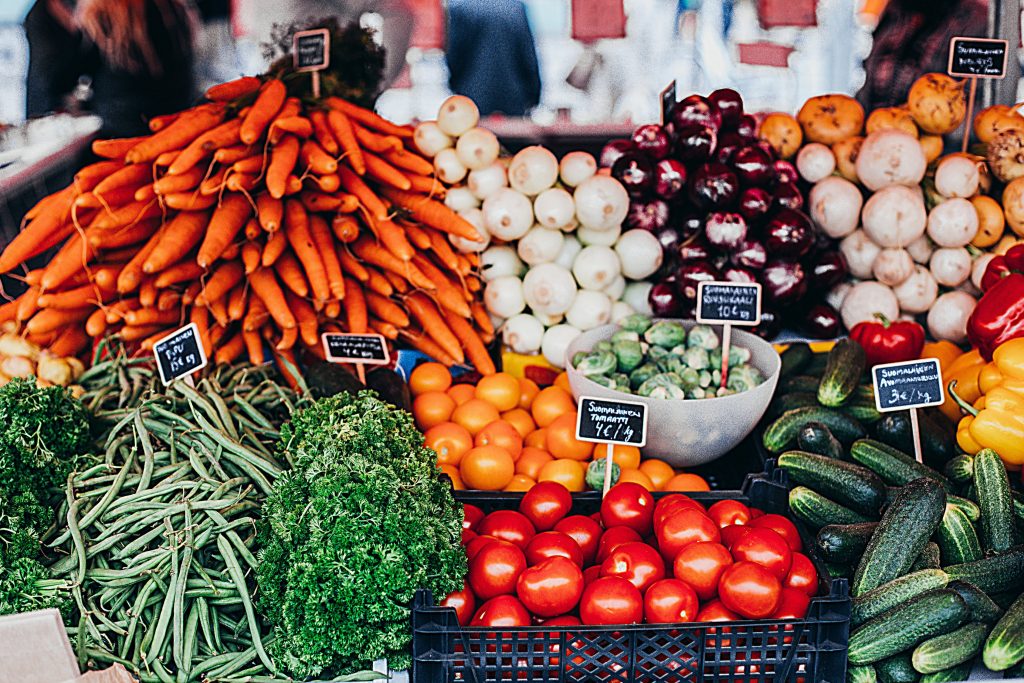
4. Fruits and Vegetables
Those who consume a diet rich in fruits and vegetables have a healthier, more glowing skin than is achieved from exposure to the sun. Fruits and vegetables are hands down the most nutrient-dense and low-calorie foods on the planet. They contain vitamins, minerals and antioxidants that keep the body healthy and reduce the risk of disease. It’s no wonder that vitamin and other supplement manufacturers turn to fruits and veggies for their precious nutrients, which they jam into a pill. Why not get the vitamins, minerals and nutrients in their natural, unprocessed state straight from the source instead?
Vegetables that contain high levels of carotenoids like beta carotene, protect against free radicals and sun radiation, both of which are known to lead to premature skin aging. Most fruits and vegetables are extremely rich in Vitamin C, the powerful antioxidant necessary for collagen production. Studies have shown that skin’s antioxidant activity increased by 37% when people consumed 180 mg of Vitamin C daily for a period of 4 weeks.
When a Japanese study measured skin quality of more than 700 women, it found that those who consumed yellow and green vegetables on a regular basis had fewer wrinkles. It’s clear that fruits and vegetables provide not only overall health benefits, they also help prevent free radical damage to skin, thanks to their strong antioxidant effects. So, what are skin’s favourite fruits and vegetables?
Blueberries
Known as one of nature’s most potent superfoods, blueberries are an amazing source of PREbiotics — dietary fibers that stimulate and nourish the PRObiotics, which is good bacteria in the gut that helps alleviate inflammation even in the skin.
Packed with powerful antioxidants that destroy free radicals, which damage cells and accelerate skin aging, blueberries also help strengthen collagen fibres as a result of their high levels of anthocyanins — certain chemicals produced by the blueberry plant that give the berries their dark blue-violet colour. Blueberries also contain folate, copper, Vitamins A and E, beta-carotene, choline and manganese. It’s not by chance that this little berry is known as the “King Antioxidant” in the fruit family.
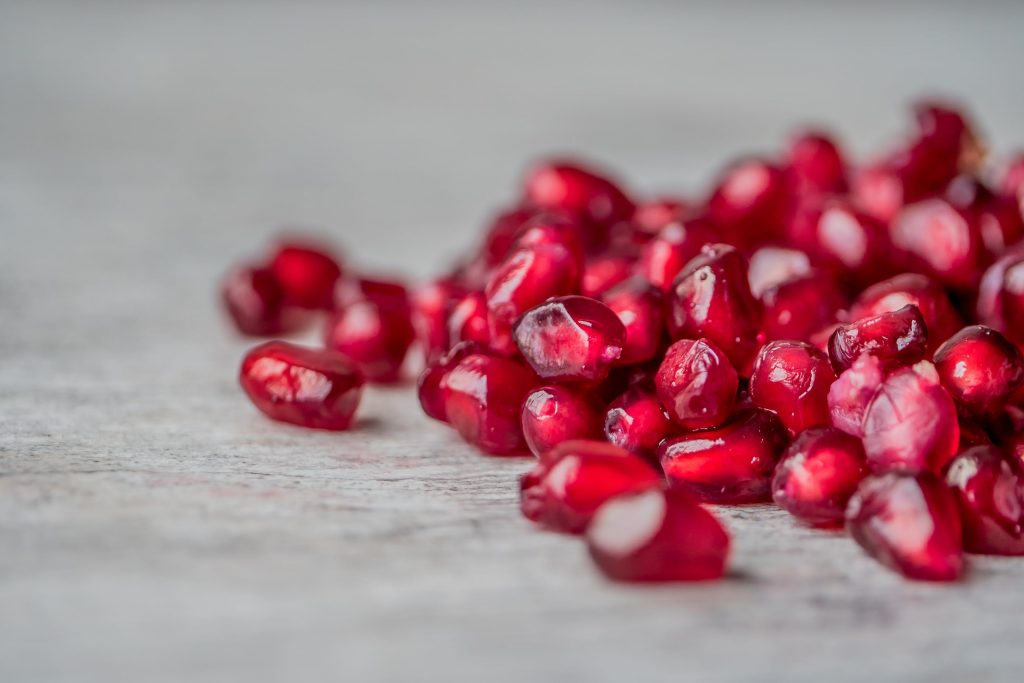
Pomegranates
Pomegranates don’t get the credit they deserve. They truly are one of the healthiest fruits in the fruit kingdom. Did you know that their antioxidant power trumps that of green tea? Their remarkable nutrient profile boasts Vitamins C and K, fibre, folate, protein (yes, 3 grams protein in one cup of pomegranate arils) and potassium.
With all those nutrients at play, pomegranates decrease inflammation, help prevent as well as repair skin damage and increase collagen production. It works really well juiced, in salads, in smoothies and, my favourite, in oatmeal.
Papayas
One of the tropics’ greatest fruit, the papaya is known for its many active enzymes and antioxidant-rich, collagen-boosting Vitamin C. The papain enzyme it contains helps keep skin blemish-free, while the chymopapain enzyme (another enzyme present in it) reduces inflammation, one of the top culprits of skin conditions.
Want to treat acne at home? Put the papain enzyme to work by smearing a piece of ripe papaya
on your face. This amazing enzyme not only cleanses the skin, it also dissolves fats that clog pores. Goodbye acne!
Aside from Vitamin C, papaya is also rich in powerful antioxidants like Vitamins E and A which help prevent free radical skin damage, therefore keeping signs of aging at bay.
Sweet Potatoes
Those who consume primarily red and orange vegetables are known to have the much- coveted sun-kissed complexion, and it’s all due to the disease-fighting compounds called carotenoids that give those vegetables their hue.
Carotenoids like beta-carotene keep skin healthy by acting as a natural sunblock. This incredible antioxidant helps protect the skin from sunburn and what’s associated with it — skin cell death and wrinkles. It is the beta-carotene that contributes to a healthier skin appearance, because it adds that warm, orange hue to the skin.
The body converts beta-carotene into Vitamin A (also known as the beauty industry’s retinol), so beta carotene is Vitamin’s A precursor. Vitamin A is not only great for healthy skin, it’s also great for the immune system, eye health and vision. So where can we get the most beta-carotene? Sweet potatoes are one of the best sources. Half a medium baked sweet potato provides 200% of the daily recommended beta carotene intake.
Even half a cup of this amazing potato contains enough beta-carotene to provide nearly four times the recommended daily intake of Vitamin A.
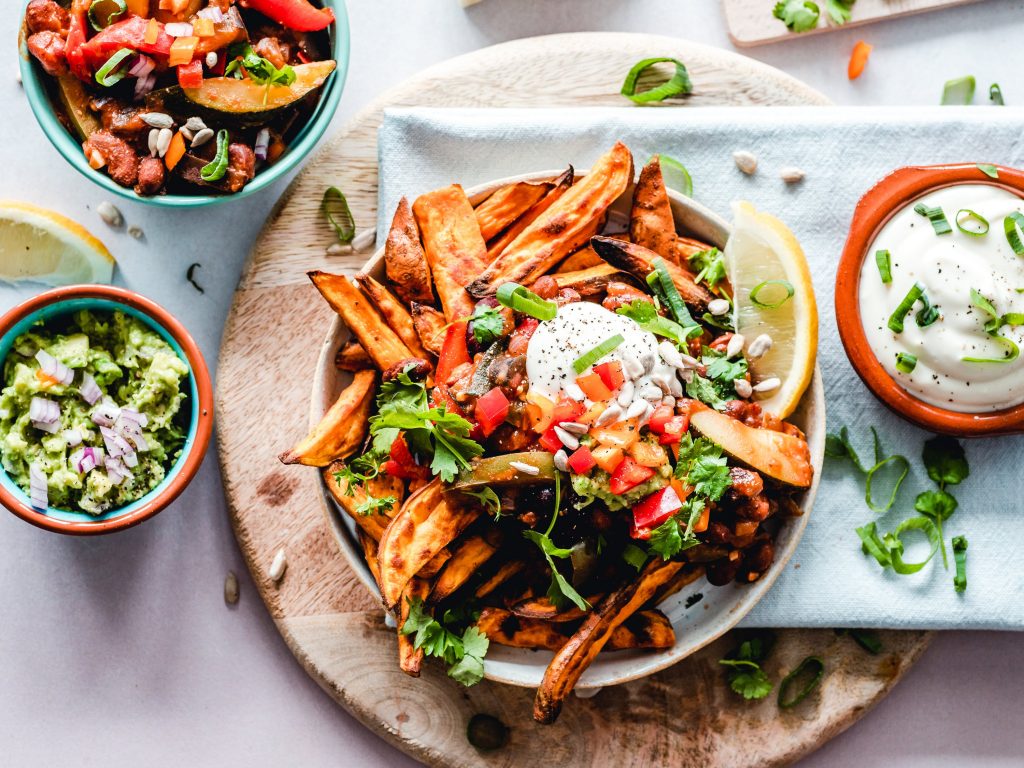
So skip the regular fries — cut real sweet potatoes in the shape of fries and bake them
instead, and you’re taking in some real great nutrients for that glowing complexion.
Carrots
Carrots are so rich in the antioxidant beta-carotene that they were actually named after it. This amazing root vegetable is not only great for the eyes, but also for clearing up acne. How does it actually do that? Well, the powerful antioxidant Vitamin A (remember, the body converts beta carotene into Vitamin A) prevents overproduction of cells in the epidermis, the outermost layer of the skin. It’s Vitamin’s A’s job to speed up cell turnover, causing the body to manufacture new cells, and that means fresher, smoother skin.
Without the amazing Vitamin A, dead skin cells would mix with sebum to clog pores, leading to acne, as well as dry, dull and wrinkled skin.
Vitamin A is also crucial in fading sun spots, age spots and hyperpigmentation. It also evens out the complexion over time and plays an essential role in reducing the development of skin-cancer cells. It’s no wonder skin loves carrots. Grated in a salad or enjoyed as a midday snack is the best way to give your skin some TLC.
Red and Yellow Bell Peppers
Like their sweet potatoes and carrots vegetable family members, bell peppers are a great source of beta-carotene (the much-loved vitamin A), also known as retinol — the well-known superstar on the skin-care circuit and for good reason. Retinol enhances collagen production, helps accelerate skin cell turnover and reduces the appearance of aging, uneven texture and age spots.
One cup (149g) of chopped red bell pepper contains the equivalent of 92% of the recommended daily intake of Vitamin A. 92% (!!!) They are also one of the best sources of Vitamin C, necessary for the production of collagen, which is what keeps skin firm and strong. The consumption of the same amount of this amazing vegetable (149g or 1 cup) provides a whopping 317% of the recommended daily intake of Vitamin C. Who can say no to this kind of skin health power?
Broccoli
Broccoli’s claim to fame is for being one of the most amazing powerhouses of the vegetable world. And for good reason since aside from the protein and calcium that it contains, it’s chock full of vitamins and minerals important for skin health, including Vitamins A and E and zinc. And if that’s not enough, broccoli also contains sulforaphane, a compound that protects against sun damage, by reducing the number of skin cells damaged or killed by UV rays by up to 29%. Studies have also shown that sulforaphane can preserve collagen levels in the skin.
And wait, there’s more — broccoli also contains lutein, a carotenoid that performs like beta-carotene and protects skin from oxidative damage
Broccoli can be best enjoyed steamed with a drizzle of extra virgin olive oil and a little bit of garlic, alongside fish, healthy pasta (more on this later) as well as grilled or roasted veggies.
Tomatoes
What’s a salad without tomato in it? Known for its powerfully nutritious properties, the tomato is a great source of Vitamin C and the main source of another major carotenoid, lycopene. It also boasts folate, Vitamin K and potassium, but lycopene in particular, not only offers great health benefits against cancer and heart disease, but also against skin damage from the sun and thus from wrinkling.
Studies prove that eating tomatoes with a healthy full fat (vs. low fat or no fat) increases the absorption of its carotenoid lycopene, so add some olive oil to your salad to do your skin some real good.
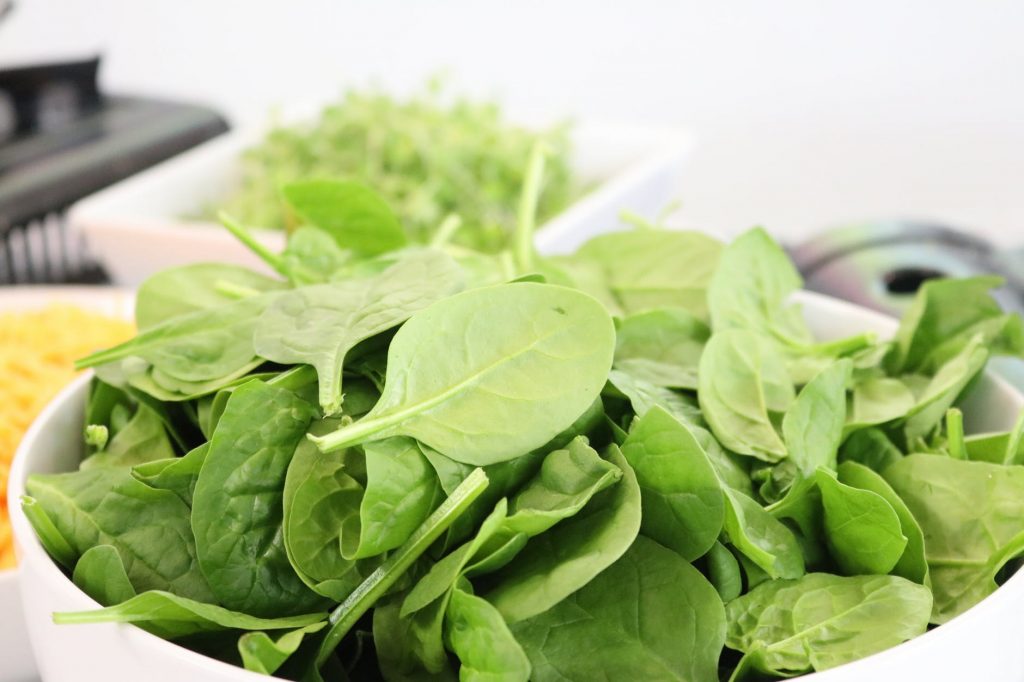
5. Leafy Greens
Even the International Journal of Cancer knows how powerful leafy greens are for health, as
studies have found that consuming leafy greens decreases the risk of skin cancer.
Spinach
Spinach is to the leafy green world what the blueberry is to the fruit world — a superfood and powerful antioxidant. This small but mighty leaf contains more nutrients than pretty much any vegetable. The superfood label is not easily earned — a simple cup of cooked spinach contains incredibly high levels of Vitamins A and K, and we all know how important Vitamin A is for skin health.
Vitamin K’s superpower is helping with blood clotting and faster healing. It’s astounding that with only 41 calories per cup, spinach also contains a plethora of other vitamins and minerals, such as the famous Iron as well as fiber, Vitamins A, B2, B6, C and E, magnesium, protein, chlorophyll, potassium, folate (a whopping 65% of the recommended daily intake), copper, manganese and calcium. With that kind of nutrient profile, it’s no wonder Popeye devoured cans of this incredible strength-enhancing leafy green before he would defeat his enemies who were multiple times his size.
Clearly spinach is not only for strength and big muscles — it’s also for great health and glowing skin. The high levels of antioxidant vitamins like A, C and E alongside folate (an essential B vitamin that repairs and maintains the DNA) not only helps defend against skin cancer and oxidative stress, but provides the skin with what it needs for its health and collagen synthesis — thank you Vitamin C!
Best consumed raw, spinach works really great in smoothies and is especially ideal in salads. As Popeye said, “I am strong to the finish… ’Cause I eats me spinach.”
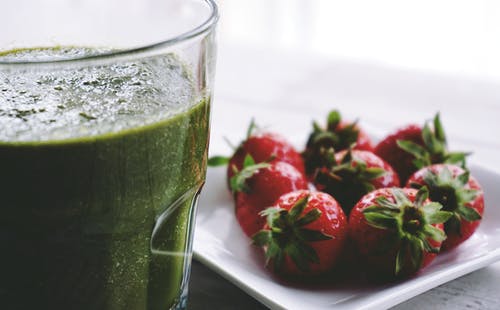
Kale
Remember when kale became big and it was everyone’s favourite superfood? Well that was for a good reason because this amazing leafy green is packed with lutein, a carotenoid that promotes the production of collagen and the renowned antioxidants Vitamins A, C and E, as well as K.
Aside from its speedy healing properties, Vitamin K helps minimize the visibility of spider veins, scars, bruises, stretch marks and tightens the skin reducing fine lines and wrinkles. It also helps reduce dark circles found under the eyes. The famous Vitamin C builds and maintains collagen giving structure to skin while Vitamin A repairs skin and prevents damage from free-radicals.
Consuming kale juice does wonders for the skin and, believe it or not, it can also be used as a skin cleanser given its detoxifying properties and its antioxidant content. Applying kale juice on the skin in the morning is a great way to feed your skin with the most powerful nutrients as you start your day. Drinking the juice detoxifies and keeps skin healthy from within.
You can also enjoy this amazing leafy green in smoothies, salads or steamed as a side dish in your meal.
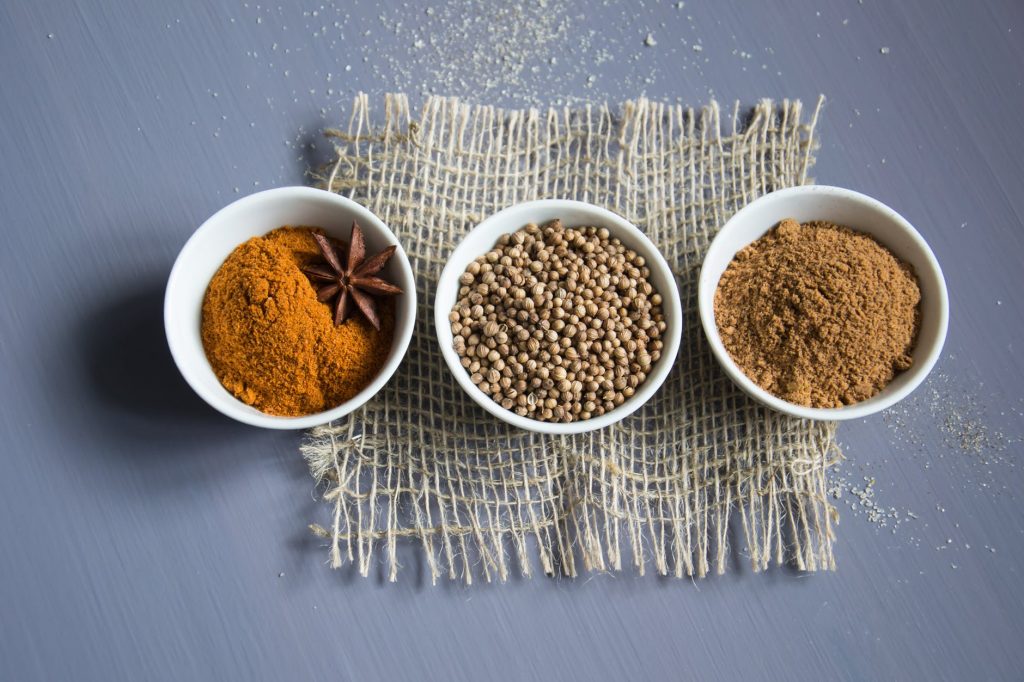
6. Spices
Many cultures have been using spices for skin health and youthfulness for thousands of years. They are the most versatile foods out there since they can not only be ingested but also applied topically. Their anti-inflammatory properties cannot be emphasized enough and that goes for more than just the skin.
Turmeric
Turmeric is hands down the most powerful spice on the planet. In fact, it’s one of our greatest natural weapons against cancer since it’s loaded with nutrients and powerful antioxidants. One single ounce of turmeric contains 26% of the manganese daily requirement and 16% of iron’s daily requirement. It’s also a source of fibre, minerals like magnesium and potassium, and Vitamins B6 and C.
This Indian spice is also the greatest anti-inflammatory thanks to its incredible active antioxidant, curcumin which also happens to be the most effective free-radical fighter. Turmeric can also help lighten age spots, dark spots, sun spots and scars. It also reduces redness caused by blemishes and fights acne really well, given its natural antiseptic properties.
In addition, turmeric also works well on skin conditions like eczema and rosacea and stimulates circulation, which helps depuff the undereye area and reduce under-eye darkness typically caused by poor blood circulation.
Studies have also shown that moisturizing creams that contain turmeric as an ingredient can help improve the appearance of fine lines. And because it’s so powerful, turmeric also helps prevent the loss of skin elasticity caused by exposure to the sun’s UV rays.
Cinnamon
Known for its amazing flavour, great aroma and powerful medicinal properties, cinnamon has been used for healing dating back thousands of years. This incredible spice is packed with nutrients and antioxidants that make it great not only for metabolism and sugar balancing, but for skin, too. Its antibacterial and antifungal properties help fight blemishes and acne. Studies show that cinnamon also increases collagen production.
Apart from flavouring lattes, mix cinnamon with honey to remove acne, with olive oil to combat aging, with regular yogurt to exfoliate and with coconut oil to address blemishes.
Ginger
If you’re like me, you consume ginger every single day — I always add it to my morning smoothie and my tea alongside lemon. Since it’s labeled as a warming food, nothing will warm you up from the inside on those cold winter days like ginger can. But it does so much more. Its anti aging benefits are endless, since it contains 40 (yes, 40!) antioxidant properties that reduce the appearance of hypo-pigmentation — white spots or spots that are lighter than the natural skin tone — and inhibit free radical damage therefore protecting against aging. The same antioxidants are also what fight against wrinkles, fine lines and skin dullness.
If your skin tends to get inflamed, this spice is a must-have, since like its cousin turmeric, ginger will reduce inflammation. It’s also great for blood circulation, which not only brings nutrient-rich blood to the skin, but also to the scalp, so it helps promote healthy skin as well as healthy hair and hair growth as well.
Consume fresh ginger as much as possible to get access to all its nutrients. Add a couple of fresh slices to warm water and lemon, to smoothies, to sauces and marinades, stir-frys, spreads and dips.
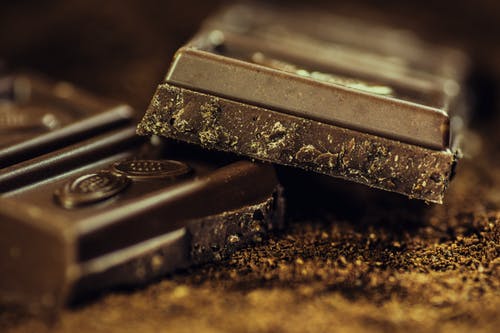
Cacao / Dark Chocolate
Most don’t need to be told twice to embrace chocolate. Chocolate is great not only ingested but
applied topically as well. Skin is the membrane between our inner and outer world. Skin allows the outside world in and what goes in shows up on the outside of it. In essence what we put on it ends up in our body and what we put in our body eventually shows up on our skin, so it’s obvious that a great diet is required for overall skin health.
Cacao is a very powerful antioxidant, packed with nutrients that do so much for overall health, including skin health. Antioxidants in particular protect and repair the skin from damage and premature aging. Its potent anti-inflammatory properties do a lot for the complexion — it reduces redness and helps eliminate blemishes. The secret to its nutrients is in keeping it in as natural a state as possible. Heavy processing turns cacao into cocoa. The distinction — and its benefits — lie in the processing. The benefits can only be derived from the cold-pressed, unroasted beans. So forgo the sweet chocolate, and enjoy the dark variety instead; it’s the dark chocolate the skin loves and gets its nutrients from.
The cacao bean contains upwards of 300 nutrients, including vitamins, minerals, antioxidants, enzymes and amino acids. It’s rich in calcium, magnesium, iron, zinc, beta- carotene and omega 6 fatty acids. The skin uses these to protect itself against damage from environmental factors and fight the effects of aging. The antioxidants (aka flavanols) kill two birds with one stone: first, they maintain the health of blood vessels; this in turn supports the second, which is to help with blood flow to the skin (and other tissues). The nutrient-rich blood feeds skin cells with what they need to keep the skin looking vibrant, glowing and youthful.
Choose a dark chocolate with at least a 70% cacao (not cocoa) proportion. Used topically, raw
cacao provides its nutrients directly to the skin, thereby improving its texture and glow.
Antioxidants nourish the skin, leaving it healthy, resilient and rejuvenated. You can also mix
cacao with turmeric and honey to make a mask that will deliver the most powerful nutrients the
skin can get.
What we ingest (food and beverages) has a huge impact on skin health so it’s of paramount
importance that skin stays properly hydrated and gets enough essential nutrients to be and look healthy. Overall, it needs a diet that consists mainly of water for hydration and antioxidant rich foods such as cacao, berries, fruits and vegetables, as well as vitamin rich foods such as tomatoes, kale, spinach, broccoli, almonds, sweet potato, avocados, walnuts, bananas, oats and other whole grains.
Healthy, glowing skin always starts with what you have in your cupboard, so there’s no need for expensive creams and lotions. Your first step to beautiful, healthy, glowing skin starts right in your kitchen.
Make this amazing, powerful anti-inflammation mask supported by nutrition to start your journey to healthy, glowing skin!
THE MOST POWERFUL ANTI-INFLAMMATORY MASK
Ingredients:
● 3 tbsp fresh lemon juice (from a real lemon)
● 2 tbsp raw honey (or Manuka honey)
● ½ tsp hemp milk (substitute with almond or other nut milk)
● ½ tsp organic turmeric powder
● ½ tsp organic cacao powder
● ½ tsp organic apple cider vinegar
● ½ tsp extra virgin olive oil
● 1 tsp full spectrum CBD oil (optional, but really great if you have access to it)
Directions:
In a bowl, stir all ingredients together. Apply to freshly cleaned, moist face — avoid getting the mixture into the eyes. Leave on for 30 minutes before washing off with a gentle towel. Note: To remove stains from the turmeric on your skin, use a cotton round or cotton ball soaked in coconut oil on the affected area.
~Simone Gisondi, RHN